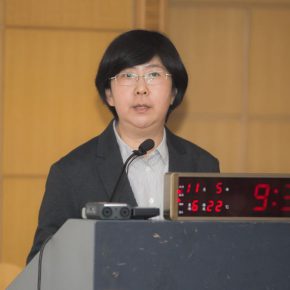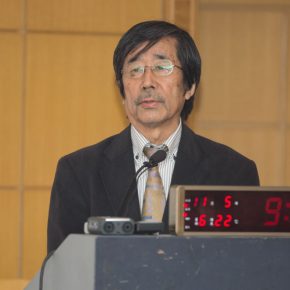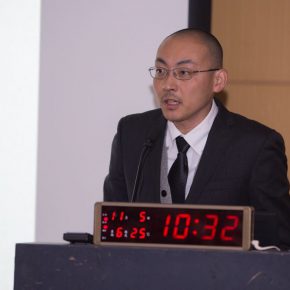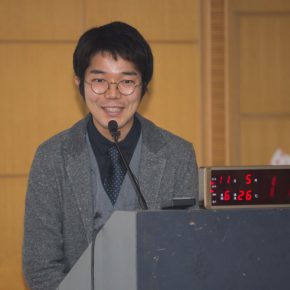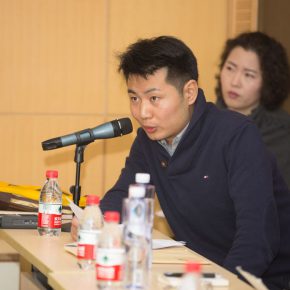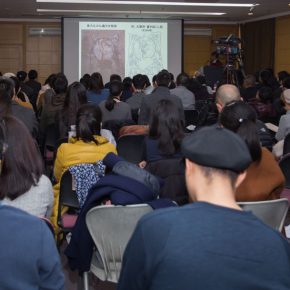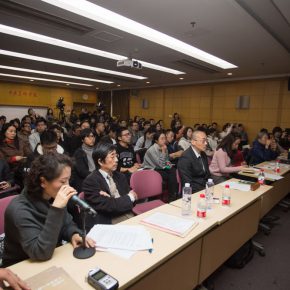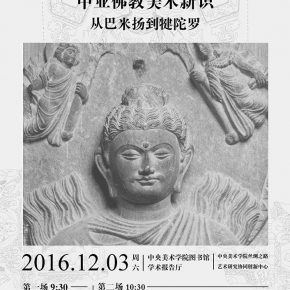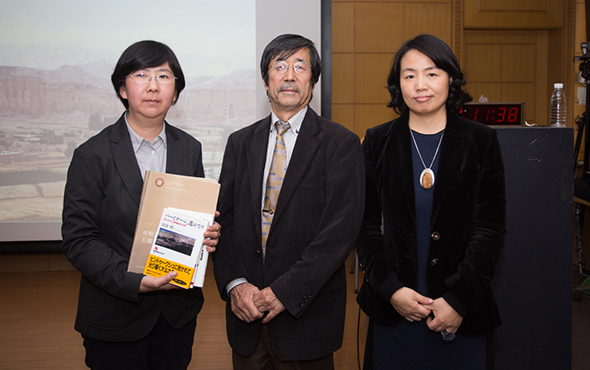
Prof. Zhang Peng and Director Yue Jieqiong received the donation by Miyaji Akira on behalf of the Silk Road Art Research Collaborative Innovation Center
On December 3, 2016, The Central Academy of Fine Arts launched two lectures on the “New Knowledge of Buddhist Art in Central Asia – From Bamyan to Gandhara”, which were hosted by the Silk Road Collaborative Art Research Innovation Center at CAFA, being part of the series of lectures entitled “Meeting on the Silk Road”.
For thousands of years, the spirit of the Silk Road, a worldwide historical and cultural heritage, has being passing on. In 2013, China proposed to build the strategic visions of the “Silk Road Economic Belt” and the “21st Century Maritime Silk Road”, and released the “Vision and Action to Promote the Construction of the Silk Road Economic Belt and the 21st-Century Maritime Silk Road” in 2015, and it put forward the promotion for the full implementation of the year, based on an anticipated start date. One of the important points is to strengthen exchange and mutual learning between various civilizations.
The Silk Road Collaborative Art Research Innovation Center at CAFA was established in June 2015, since the start over a year ago it has held a series of activities such as domestic and international exhibitions, exchanges, academic seminars and so on. Following the invitation of the Italian scholar to introduce Pakistan’s Buddhist archeology and art research in 2015, it has had an opportunity to invite Japanese scholars of the year. In short, the Center hopes to carry forward the tradition of the Central Academy of Fine Arts, to establish the mechanism of collaborative innovation, integrating cutting-edge academic strength at home and abroad, to build a high-end academic platform to carry out multi-regional and international exchange and cooperation. It is through continuous academic exchange that academic research can be built and an exchange platform established to offer a new vision and ideas, to establish the relationship between today and the future.
Video recording the first session (or click on the “Video” column of the Home of CAFA ART INFO to watch it):
Miyaji Akira: A Review of the History of Bamiyan GrottoesIn the first session, Miyaji Akira introduces a lecture entitled “A Review of the History of Bamiyan Grottoes”, Zhang Peng, Deputy Director of CAFA Editorial Office “Art Research”, Deputy Director and Secretary-General of the the Silk Road Collaborative Art Research Innovation Center at CAFA hosted the lecture.
Miyaji Akira is a famous Japanese historian of Buddhist art, honorary professor of Nagoya Gakuin University and Ryukoku University. He has published a large number of monographs on Buddhist art and archaeology, such as “Indian Art History”, “Indian Buddhist Art History”, “Gandhara Buddhas”, “Art of Ancient Japanese Temples”, “World Art Collection – India”, “The Distant Bamyan”, “The Origin of the Study of the Buddhas”. Among them, “Nirvana and Maitreya’s Imageology – From India to Central Asia” and “Tuyugu Grottoes Murals and Zen” were published in Chinese. From 1969 to 1978, Miyaji Akira conducted a survey of the Bamian Buddhist Ruins in Afghanistan. He followed the archaeological teams of Nagoya Gakuin University and Kyoto University to investigate the Bamian Grottoes on 4 occasions and published a relevant archaeological investigation report, which comprehensively records the Bamian ruins.
Video of the second session (or click on the “Video” column of the Home of CAFA ART INFO to watch it):
Shunpei Iwai: A New Study on the Chronology of the Bamian Valley Monastery and Recipes Satoshi Naiki: A New Explanation to the Unearthed Sculptures in Gandhara AreaHosted by Yue Jieqiong, Director of the Silk Road Collaborative Art Research Innovation Center, the second session highlights the speeches by Shunpei Iwai and Satoshi Naiki.
Shunpei Iwai is an Associate Professor from Ryukoku University. Iwai has conducted archaeological investigations in various places in Central Asia since 1999, including the restoration of Buddhist monasteries in Uzbekistan, the Southeast Palmyra Cemetery in Syria and the Bamiyan ruins in Afghanistan and Tajikistan. The publication of academic monographs and papers include “Archaeological Study on Tochari Geographical Relation”, “Buddhist Monastic Change of Afghanistan and the Surrounding Areas”, “Origin and Development of Bamian Buddhist Murals and the Chronological Research”, “Underground Investigation of Bamian Ruins” and so on.
Satoshi Naiki is an Assistant Professor of Kyoto University and a Doctor of Archeology from Kyoto University. His main research areas include Gandhara Buddhist Art, Pakistan Archeology, and Archeology in Central Asia. Satoshi Naiki has been engaged in the archaeological survey at home and abroad all year round, experiencing a field archeological survey for many years, he has also investigated the Gandhara Buddhist artifacts in Central Asia in the collections of European and American Museums. He inherited the archeological context on Central Asian at Kyoto University, through the study in the history of techniques used in sculpture, to open up a new vision of Gandhara Buddhist art. He published academic monographs and essays including “Gandhara Sculpture and Buddhism”, “Study on the History of Ancient Hills at Gandhara Area”, “The Time of the Making of Gandhara Inscription Sculpture”, “Joining Method of Gandhara Sculpture Wrist”, etc.
Finally, Prof. Miyaji Akira donated his academic monograph to the Silk Road Collaborative Art Research Innovation Center. After the talks, the two sides also carried out further exchanges, hoping to establish more academic cooperation.
Text by Silk Road Collaborative Art Research Innovation Center, translated by Chen Peihua and edited by Sue/CAFA ART INFO
Photo and video by Hu Sichen/CAFA ART INFO


